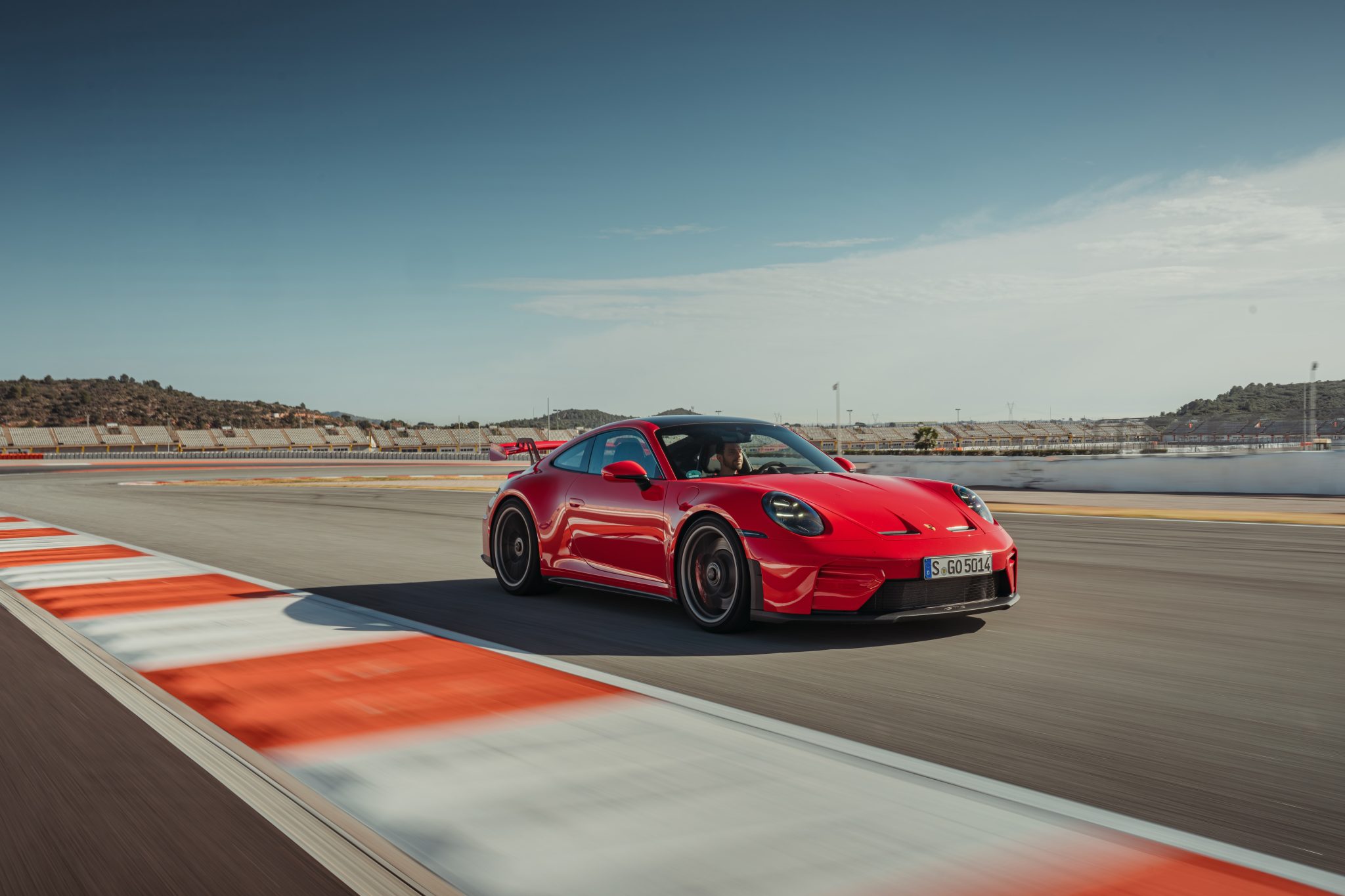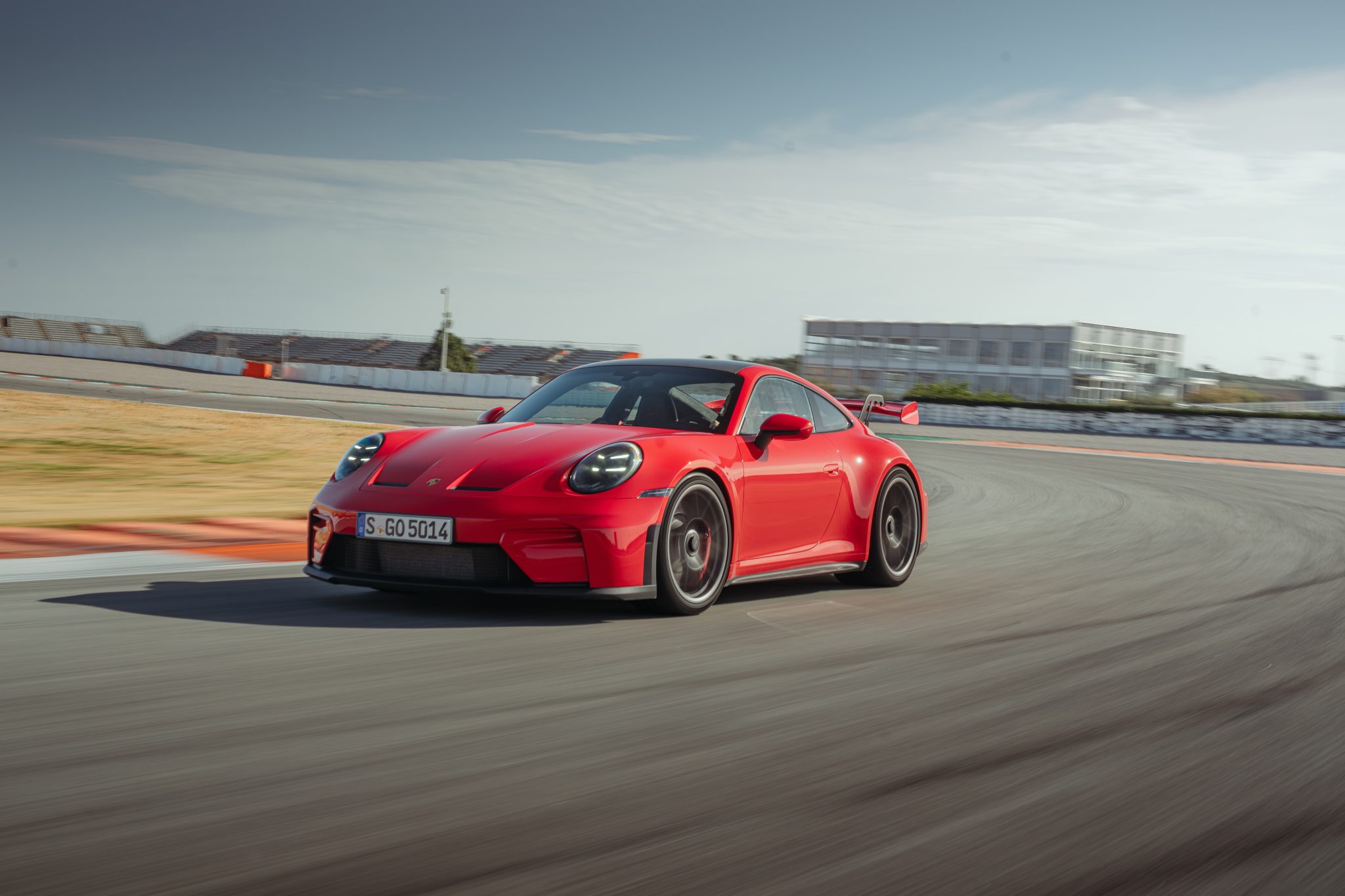2025 Porsche 911 GT3 review
For most of the 911 GT3’s life, development work focused almost entirely on one area: making the thing go faster. That meant squeezing more and more power out of a given engine capacity – higher rev limits, lighter internals, free-flowing exhausts, more aggressive cams and so on – until eventually that capacity was increased by a couple of hundred cubic centimetres, then increased again, to wring out even more.
And it meant bolting on bigger wings and spoilers to add aerodynamic downforce, and reducing unsprung weight with optional carbon ceramic brakes and forged wheels, and widening tracks and tyres to ramp up mechanical grip. For two and a half decades since the first in 1999, the GT3 evolved like a predator over millennia, steadily becoming more and more optimised so it could fly along a road or around a track faster than ever.
Regulations Over Revs: A Shift in Focus
But it seems there’s been a shift. If the product presentation at last week’s new 911 GT3 launch event near Valencia is any indication, it seems Porsche Motorsport’s engineers now spend more time with their noses buried deep inside the dense, dreary pages of governmental regulatory rulebooks, searching for a way through. Normally on these events we hear about what’s been done to increase engine output; this time, and for the first time, all of Porsche’s powertrain development work went into satisfying new tailpipe emissions legislation.
Porsche describes these new regulations as ‘severe’: in the EU, particulate emissions must be reduced by 30 per cent; in China it’s 50 per cent. Most car makers can meet them easily enough with downsized, turbocharged engines and perhaps hybrid drive. Porsche GT buyers overwhelmingly don’t want either of those, we were told, so the race-derived naturally aspirated flat-six that has powered these cars since 2013 had to live on one way or another.
Still a High-Revving Masterpiece
We’ll come on to the hows and wherefores shortly, but first you need to know this: it remains one of the most intoxicating and invigorating road car engines in production. It still shrieks to a 9000rpm redline, still sounds like a continent ripping in two and still whacks a 911 GT3 up a road like it’s been kicked by Godzilla. So don’t go panicking that something fundamental might have been lost. It hasn’t.
This isn’t an all-new GT3, but the updated version of the Porsche 992-series model. Most of the rest of the line-up has been updated recently too; others will follow shortly. There are revised bumpers front and rear and some tweaks to the interior, most notably a fully digital instrument binnacle for the first time, but little else. I’m not sure I’d back myself to identify old car from new at a glance.

Photography by Porsche Newsroom – The Media Portal by Porsche
Two Flavours, One Philosophy
Like before there’s a wingless Touring version that, says Porsche, is the road car of the GT3 range. The one with the wing is, of course, designed for the track. I drove both in their own comfort zones, the Touring on the stunning mountain roads 30 minutes inland from Valencia, the regular car on Circuit Ricardo Tormo, the MotoGP track named in tribute to a Spanish motorcycle racer. I won’t try to build the suspense any further because you know what’s coming – both are wonderful to drive.
Perhaps you’re now expecting to read about the myriad ways in which the variants differ; how one has been honed for the race track, the other optimised for the public highway. But no. There’s only one significant difference, that being the towering aerodynamic device that’s either fitted proudly to the engine cover, or not at all. Actually, these 992.2 GT3s can be differentiated slightly further with some optional hardware – rear seats in the Touring for the first time, plus a ‘Lightweight’ package for that model that saves 22kg for the not insignificant sum of £29,233, and a ‘Weissach’ package for the regular GT3 that costs £19,531 (including the CFRP roll cage) and further optimises it for track driving – but their powertrains, chassis settings and even list prices are perfectly interchangeable.
Track Time in the Winged GT3
A missed opportunity? I won’t know until I’ve driven both. I start on track in a bewinged Indian Red GT3. All around here are the scars left by the terrible floods that ravaged this region of Spain late last year – the spectator car park and access roads have been torn to pieces, much of the plant life has been ripped clean out of the ground and there are ruined cars packed into far corners of the facility. (Porsche’s events people considered relocating the launch entirely; the locals asked them not to.)
Once out on circuit, you’d never know. Nor would you know Porsche’s engine builders had been forced to make any deleterious changes, for the 4-litre flat-six is as joyous here as it ever was. On track in particular it lives in that explosive region between 8000 and 9000rpm – you simply never allow it to drop any lower than that, flicking down a gear with the paddle on the left-hand side of the steering wheel any time the needle in the digital rev counter threatens to fall towards the ‘7’.
From inside and out it sounds magnificent and, though it’s hard to be sure without an immediate back-to-back comparison, you wonder if it actually feels stronger than the last one…
Table of contents

Photography by Porsche Newsroom – The Media Portal by Porsche
No Power Gains, but No Losses Either
Let’s step back. To meet those severe exhaust emissions standards, Porsche has fitted two extra catalysts to make four in total. But they don’t appear to have strangled the engine one bit. Ordinarily you’d see a commensurate drop in power, but the newly installed camshafts from the Porsche 911 GT3 RS keep peak output at the same 503bhp as before. Even so, this is the first GT3 to offer no more power than its predecessor.
No matter – 503bhp is plenty. Torque, though, falls by 15lb ft, potentially a meaningful loss for an engine that didn’t have too much to lose, one that has always lived on high crank speeds rather than a robust mid-range. The solution? Reduce the final drive by eight per cent on both manual and PDK transmissions. The result is shorter gearing and more urgent acceleration through the ratios than before. The regulatory nets may be closing in, but for now Porsche continues to wriggle free.
Not all its efforts were in the face of stricter regulations. Take the chassis – there are numerous detail changes throughout the suspension and steering designed to make this new 911 GT3 better to drive than the last. Minor tweaks to the damping expand the car’s capability in all directions, I was told, making it better on both road and track. Importantly, the engineers haven’t simply copied the limited edition 911 S/T’s homework and bunked off for the rest of the day; the S/T is very intentionally road-biased, say the chassis wizards, while any car wearing GT3 badging must be supremely capable on track as well.
New components within the suspension increase anti-dive geometry, keeping the car flatter when braking hard from high speeds. There are new bump stops, too. They’re shorter than before, increasing spring travel by 27mm on the front axle and 24mm at the rear, which means better control right at the extremes of wheel travel, such as when hitting kerbs very hard on circuit. Finally, the steering has been sharpened up around the straight ahead for keener responses. The various tyre options have also been tweaked to generate more outright grip in all conditions (the test cars wore Michelin Pilot Sport Cup 2s).
Weight has crept up by around 20kg over the previous model, thanks in large part to yet more new regulations, this time concerning impact safety and the additional bracing material that’s been added to the doors to comply with them. Those additional cats won’t weigh nothing either. Porsche will point out that the Lightweight and Weissach packages, plus optional magnesium wheels that cost £13,759 and save 9kg, more than compensate – I’ll point out that they’re all really quite expensive.
Sharper, Tauter, More Controlled Than Ever
Individually the chassis changes are minor, but they add up to much more than that on track. There is huge grip and serious agility like before, but also a steadfast, rock-solid stability that’s new. You can hammer this thing around a circuit as hard as you dare lap after lap and not once feel it trip into unplanned oversteer or collapse into understeer. It is so tautly controlled, so planted, so keyed into the track surface you feel fully confident in it from the first corner.
In fact, I don’t recall earlier versions of the GT3 RS feeling this locked down on circuit. Of course you can provoke it into lurid slides, but all that poise means you instead chase it harder and harder around the lap, as a racing driver would. At the extremes, like when you thump the car at speed over a sausage kerb, the GT3 soaks it all up, deals with the landing in one up-down stroke of the dampers, then darts towards the next bend. Even from the top of sixth gear, the (ahem, £9087) carbon ceramic brakes haul the car down for a tight corner like you’ve driven into thick treacle, and lap after lap those brakes, the tyres, the engine, the gearbox, all of it feels just as it did at the start of the session.
You’d swear there’s more aerodynamic downforce now, but in fact the new GT3 generates the same 140kg at 124mph as the last. It’s those chassis tweaks that make the difference, particularly the revised anti-dive geometry that provides such a stable platform for the aero to act upon while braking for a turn. This is the best track day GT3 there’s been, no question.
The GT3 Touring’s Moment
In the hills outside Valencia you’ll find some of the best driving roads in the country. I’ve swapped the Indian Red GT3 for an Oak Green GT3 Touring. It has the Lightweight pack and a manual gearbox but no rear seats – almost, but not quite, my perfect specification. Up here the car is sublime. On these roads you really notice the extra precision in the steering, feel the benefit of that shorter gearing that finally answers one of the few significant criticisms we’ve had of naturally aspirated GT Porsches over the past decade.
Those tightly stacked ratios make this GT3 feel more urgent than the last under a wide open throttle, despite the drop in torque, and you also get to rifle through the gears and enjoy one of the best shifts in the business much more often. Nor are the ratios suddenly irritatingly short – second gear will still pull to beyond 70mph. The trade-off is a few mph lopped off the top speed, which is neither here nor there, but also more engine noise whatever you’re up to. At typical UK motorway speeds, the engine spins away beyond 3500rpm in top gear. I’m sure there’s more transmission whine too.
But out here you feel all the same poise, control and stability that so impressed on circuit; yet this isn’t one of those numb, aloof performance cars that feels lifeless on the road – you are so connected to it, so dialled into its major controls, so aware of the grip rising and falling and the weight transferring around the car you’re involved every step of the way. And no car with an engine and transmission like this could ever be called lifeless.
Table of contents

Photography by Porsche Newsroom – The Media Portal by Porsche
The Jury’s Out for UK Roads
These roads are smoother than silk, and here the GT3’s damping is exceptional. On the multilane highways there’s a classy, polished feel to it, like it’s skimming lightly across the road surface. But there is still a question mark here – the previous GT3 could feel tense and uptight on the UK’s craggy and crumbling road network, and despite Porsche’s claim that this latest GT3 should be better able to deal with a poor surface, I could feel no evidence of that on the few patches of bad asphalt we did come across. I strongly suspect this car will feel quite unyielding on our roads as well. Time will tell.
There was a plinth in the pit garages at Circuit Ricardo Tormo proudly displaying both versions of the new 911 GT3. On the wall behind the regular car was an image of a race track with big red and white rumble strips. Behind the Touring, a mountain road twisting off into the distance. The message couldn’t be clearer. But given their different objectives, why must the two share suspension settings? Maybe Porsche can’t bring itself to release into the world a car wearing GT3 badges that isn’t absolutely scintillating on track. Ask the engineers and that’s more or less the answer that comes back. But with road-biased damping, S/T style, and perhaps even slightly softer springs (since there’s no downforce to support), the GT3 Touring could be the greatest performance road car on sale by a distance.
Conclusion: A Masterpiece Facing an Uncertain Future
So, a missed opportunity? It is for me, but then I have a UK-centric view of these things. On the best roads in Spain, France, Germany and elsewhere, a more road focused set-up simply isn’t necessary.
I would only be in a hurry to upgrade from the previous GT3 to this new one if I really wanted rear seats in my Touring. These cars don’t need to become any quicker now, nor any more capable dynamically, so it doesn’t matter so much that Porsche’s GT department is being forced to switch its focus away from making them go faster to simply keeping them alive in their current form.
Nobody will say how long they have left, but it’s possible – not probable, mind you, just faintly possible – that you’ll never read a first drive review of a non-hybrid, non-turbocharged new Porsche 911 GT3 again.
Table of contents
|
|
2025 Porsche 911 GT3 |
2025 Porsche 911 GT3 with Touring package |
| Engine | 3996cc, 6-cyl, naturally aspirated | 3996cc, 6-cyl, naturally aspirated |
| Transmission | 6-speed manual or 7-speed dual-clutch (PDK), RWD | 6-speed manual or 7-speed dual-clutch (PDK), RWD |
| Power | 503bhp @ 8500rpm | 503bhp @ 8500rpm |
| Torque | 332lb ft @ 6250rpm | 332lb ft @ 6250rpm |
| Weight | 1462kg manual, 1479kg PDK | 1461kg manual, 1477kg PDK |
| Power to Weight | 344bhp/tonne manual, 340bhp/tonne PDK | 344bhp/tonne manual, 341bhp/tonne PDK |
| 0-62mph | 3.9sec manual, 3.4sec PDK | 3.9sec manual, 3.4sec PDK |
| Top Speed | 194mph manual, 193mph PDK | 194mph manual, 193mph PDK |
| Price | £157,300 | £157,300 |
| Ti Rating | 9/10 | 9/10 |


